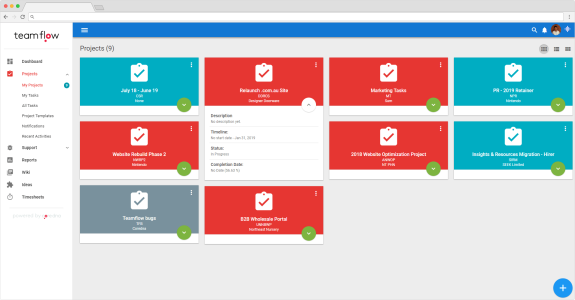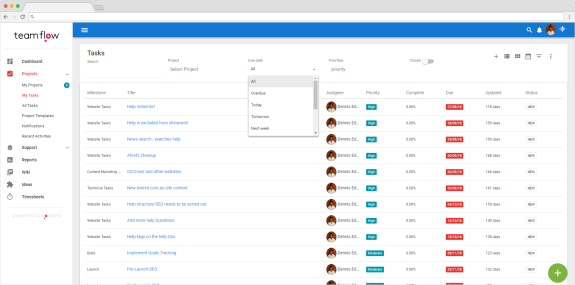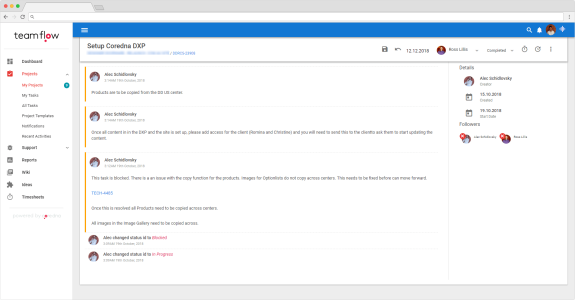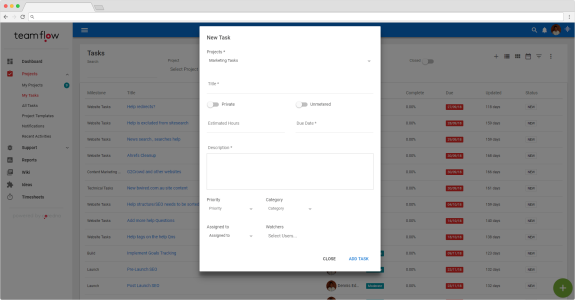Best Project Management Tools for Digital Agencies: Revealed

Choosing the right project management software can make or break a digital agency’s success. We analyzed what high-performing core teams use to stay aligned, productive, and scalable. Running web projects is tough for a number of reasons, running complex web projects can start to get very complicated very quickly. With lots of moving parts, inputs from a number of people there is a lot to coordinate and more often than not, it’s on a critical deadline. That's where useful tools come in.
A study by Gallup revealed that only 2.5 percent of companies complete their projects successfully. That’s an alarming statistic that doesn’t just include digital agencies, but every sector right across the board.
But each sector is different and has their own project management challenges. Digital agencies have their own set of problems which we are very familiar with, so we developed our own solution, Core Teams, that aims to soothe your project management woes.
Key takeaways
- Tailored for Digital Agencies: Core Teams is a project management tool built by Core dna, specifically designed to address common challenges digital agencies face.
- Solves Key PM Issues: It tackles issues like project overload, poor communication, remote team management, scope creep, and tool overload.
- Centralized & Collaborative: Offers a centralized dashboard, priority tagging, collaboration tools, and real-time updates to streamline project tracking.
- Flexible & Integrative: As a SaaS product, it's accessible anywhere and integrates easily with other tools like Trello and Asana.
On this page:
Introducing Core Teams: A project management system by Core dna
Before software became our passion, our team, led by Sam Saltis, ran a successful digital agency for 15 years. In that time, our team lived through the project management challenges that affect digital agencies worldwide — and that’s why we created Core Teams.
Core Teams is a SaaS-based project management tool that has been designed and developed for digital agencies. For the same reason we created Core dna, our one-of-a-kind decoupled SaaS CMS platform, we couldn’t find a suitable project management tool that could meet the requirements of the modern-day digital agency, so we decided to create our own solution.
By combining our technical expertise in application development and our experience and knowledge of working with digital agencies (and not forgetting the fact that we used to be a digital agency ourselves), we created Core Teams.
Top 5 agency project management challenges (and how Core Teams helps)
The idea for developing Core Teams came about when we noticed the same project management issues kept creeping up.
1. Becoming overwhelmed by multiple projects
Whenever a new client signs a contract with your agency, it’s always a good sign. It’s proof that your agency is growing and you are increasing your revenue. But while having multiple clients is an excellent position to be in, making sure all your clients are happy is a different ball game.
For one, as your pool of clients grows, you will have to manage more projects and encounter conflicting deadlines. And as you manage more projects, you might find that you don’t have enough resources to stack things up and you end up spending more time managing a backlog of task than managing your team.
When you have so much going on, even the most organized individual can get caught out. Forgotten assignments can suddenly rear its head to remind you of a looming deadline that you lost track off. And then you end up making hasty decisions to get all your resources together and take your team off their assigned projects to complete that assignment you “accidentally” forgot about.
This is not just the case of trying to get your act together and getting organized, but if you do have too much on your plate, you will sink. That’s why it is crucial for you to have some breathing space.
2. Poor communication
Poor communication within a digital agency team is the biggest obstacle that gets in the way of successfully delivering projects. In fact, a well-cited study by the French computer manufacturer, BULL, highlighted that 57 percent of projects fail due to a breakdown in communication.
It's no secret for me to say that communication skills should be a project manager’s greatest asset. That’s why there’s a lot of emphasis in this area. Whether you’re providing instructions to your team or seeking information from clients, it is always a challenge to maintain clear and open communication.
3. Globalized teams
While projects are collaborative in nature, we can’t deny how companies have evolved in recent years. Thanks to the increased accessibility of the Internet, more digital agencies are now operating with teams of remote workers scattered right across the globe. Even though transitioning to a remote working model can help agencies save a considerable amount of expenditure on office space, managing a team of remote workers can have its own problems.
If your team is truly global, you will have to deal with different time zones, language, and cultural barriers. You’ll also need to figure out an effective way of sharing your resources. Plus, since managing remote teams involves little or no face-to-face interaction, communication can also become a pain point as well.
4. Scope creep
Scope creep is every project manager’s worst fear. This happens when a project starts in a certain way, but as time goes on, it begins to take a different shape and no longer looks like the same project that was originally intended.
In the beginning, it is quite difficult to know how the final project will look like. Sometimes this can happen because the client has a vague idea and is unable to clarify all the important details. This often leads to unrealistic deadlines and unclear objectives which can hamper how you want to allocate your resources.
And let’s not forget about gold plating where you intentionally add extra features or functions to impress your client. While gold plating is done with the best intentions, it can backfire as you could end up adding more features that were not demanded by the client, risking in the client rejecting your final product. Not to mention, adding new dimensions to your project introduces new sources of risk along with additional testing, documentation, costs, and timelines.
5. Access to the right tools
Thanks to recent advancements in application development, we now have the luxury to access a multitude of free and premium web-based tools to help us manage and deliver our projects. But knowing which tool to use and how to use them is an issue every project manager encounters.
There’s no point investing in a tool that is difficult to use and delivers a clunky performance. Remember, these tools are meant to make your life easier, and as a project manager, you already have a lot to contend with on a daily basis. But with so many tools to choose from, you need to set aside some time to investigate and test which tools will be right for your agency.
And believe me, we’ve used many tools to assist us with our projects, and no tool is perfect.
How Core Teams addresses these issues
On identifying these issues, we developed Core Teams to include the necessary features to address these recurring challenges that digital agency project managers face.
1. It centralizes all your projects
Core Teams lets you view all your projects on a single dashboard. You can apply a multitude of filters to view projects by due date and what’s currently open and closed. Having all your projects in one place prevents you from “accidentally” missing deadlines.

Also, there is a colored tagging system that helps you prioritize your projects so you know which project needs the most attention. Core Teams comes with the following built-in priority tags:
- Routine: Non-urgent.
- Important: Signifies that the project is of significant importance and has a tight deadline.
- Urgent: This tag indicates that the project must supersede everything else.

And as soon as the project is finished and delivered to the client, you can mark them off as complete. Core Teams also comes with a Scrum board feature as well.
2. Collaboration
Core Teams allows assigned team members and managers to collaborate, discuss, and share ideas on a particular project. Users can easily create projects and delegate them to your team members. You can also add “watchers” to the project, these could be senior management who want to oversee the project to keep up-to-date with it.

Users can exchange messages with each other, and whenever any new activity appears on the project, a notification gets sent to the email addresses of the associated parties.
This ensures all relevant stakeholders and team members are kept in the loop of the latest developments in the project.
3. It’s a SaaS product, it can be used anywhere
As long as you have a laptop and internet connection, you can access Core Teams from anywhere in the world, perfect for globalized remote working teams. Simply provide your team members with their login credentials, and they’re good to go.
Plus, with it being a SaaS product, there’s nothing to install and all the maintenance work is taken care of by the SaaS provider. Which is great news, meaning you can spend more time working on your projects.
4. Be able to regularly review and update projects
While there is no 100 percent anti-scope-creep solution, Core Teams does come with a number of tools and features that lets you document and communicate any challenges to your team, stakeholders, and management in advance.
Besides the collaboration feature, Core Teams allows you to properly plan and define your projects. You can set how long a project should take, input a detailed criteria of the project, and upload any supporting documents that are relevant to the project.

If any changes were to arise, you can simply send out a message with the update.
5. Integrate with other tools
As we mentioned before, no tool is perfect.
When we developed Core Teams, we didn’t intend on making it a one-size-fits-all solution. We designed it in a way to make it work with other tools. For example, if your clients prefer to work with Trello or Asana, then you can link your project from Core Teams over to their preferred project management tool.
Core Teams: Agency project management made easy
With Core Teams, all your projects can be managed on a single interface and you are able to delegate tasks to team members and keep watch over them.
The collaboration feature provides a platform for discussion, share ideas, and keep everyone in the loop of the latest happenings in the project so you won’t miss a beat.
For more information on how Core Teams can help your digital agency, get in contact with us today.













